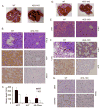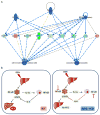Genetic deletion of AEG-1 prevents hepatocarcinogenesis
- PMID: 25193383
- PMCID: PMC4216744
- DOI: 10.1158/0008-5472.CAN-14-1357
Genetic deletion of AEG-1 prevents hepatocarcinogenesis
Abstract
Activation of the oncogene AEG-1 (MTDH, LYRIC) has been implicated recently in the development of hepatocellular carcinoma (HCC). In mice, HCC can be initiated by exposure to the carcinogen DEN, which has been shown to rely upon activation of NF-κB in liver macrophages. Because AEG-1 is an essential component of NF-κB activation, we interrogated the susceptibility of mice lacking the AEG-1 gene to DEN-induced hepatocarcinogenesis. AEG-1-deficient mice displayed resistance to DEN-induced HCC and lung metastasis. No difference was observed in the response to growth factor signaling or activation of AKT, ERK, and β-catenin, compared with wild-type control animals. However, AEG-1-deficient hepatocytes and macrophages exhibited a relative defect in NF-κB activation. Mechanistic investigations showed that IL6 production and STAT3 activation, two key mediators of HCC development, were also deficient along with other biologic and epigenetics findings in the tumor microenvironment, confirming that AEG-1 supports an NF-κB-mediated inflammatory state that drives HCC development. Overall, our findings offer in vivo proofs that AEG-1 is essential for NF-κB activation and hepatocarcinogenesis, and they reveal new roles for AEG-1 in shaping the tumor microenvironment for HCC development.
©2014 American Association for Cancer Research.
Figures






References
-
- El-Serag HB. Hepatocellular carcinoma. N Engl J Med. 2011;365:1118–27. - PubMed
-
- Berasain C, Castillo J, Perugorria MJ, Latasa MU, Prieto J, Avila MA. Inflammation and liver cancer: new molecular links. Ann N Y Acad Sci. 2009;1155:206–21. - PubMed
-
- Pikarsky E, Porat RM, Stein I, Abramovitch R, Amit S, Kasem S, et al. NF-kappaB functions as a tumour promoter in inflammation-associated cancer. Nature. 2004;431:461–6. - PubMed
-
- Karin M, Ben-Neriah Y. Phosphorylation meets ubiquitination: the control of NF-[kappa]B activity. Annu Rev Immunol. 2000;18:621–63. - PubMed
-
- Liu P, Kimmoun E, Legrand A, Sauvanet A, Degott C, Lardeux B, et al. Activation of NF-kappa B, AP-1 and STAT transcription factors is a frequent and early event in human hepatocellular carcinomas. J Hepatol. 2002;37:63–71. - PubMed
Publication types
MeSH terms
Substances
Grants and funding
LinkOut - more resources
Full Text Sources
Other Literature Sources
Medical
Molecular Biology Databases
Miscellaneous

